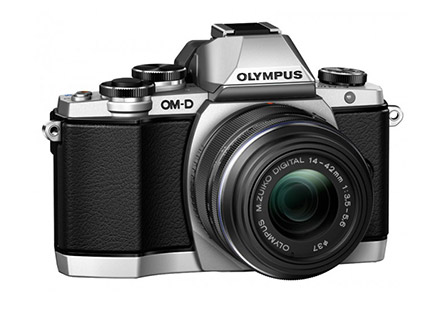Tom's Guide Verdict
The E-M10 Micro Four Thirds mirrorless camera packs a lot of features and high-quality imaging capability into a very small, sturdy body.
Pros
- +
Small compact design handles well
- +
Detailed images with true-to-life color
- +
Built-in Wi-Fi and powerful apps work well with smartphones
- +
Impressive 8-shot-per-second burst shooting
Cons
- -
Sluggish autofocus, especially in low light
- -
Aggressive noise reduction
- -
No external microphone input
- -
Some setting adjustments require multiple steps
Why you can trust Tom's Guide
The Olympus OM-D E-M10 is the entry-level model in the company's OM-D line of premium mirrorless cameras. While other models in this range have started at over a $1,000, just for the body, this 16.1-megapixel camera has an impressively low price of $799 with a 14-42mm zoom lens, or $699 for the body only. For that price it offers a full feature set that competes against both other mirrorless cameras like Samsung's $1,000 NX30 and $800 NX300, as well as DSLRs like the $650 Nikon D3300 and the $850 Canon T5i (all priced with zoom lens).
Editor's Note (8/31/15): Olympus announced an updated version, the OM-D E-M10 Mark II, which features an updated design, larger viewfinder, and 5-axis image stabilization. This camera is available for pre-order for $649 (body only) or $799 with lens.
Design
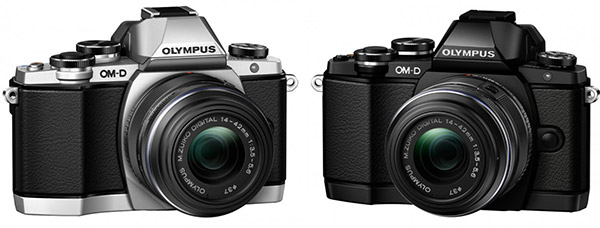
The OM-D E-M10 is a compact mirrorless camera of 4.7 x 3.2 x 1.8 inches and just under a pound in weight. That's far smaller than most DSLRs and also competes well with mirrorless cameras. The body of the Samsung NX300, for example, measures 4.8 x 2.5 x 1.6 inches and weighs 19.4 ounces, but doesn't have an electronic viewfinder or built-in flash.
The M10's body, available in black or black-and-silver, is covered in dials and buttons that allow for quick adjustments. A small handgrip, however, fails to provide much of a grasp.
On the back of the body, a 3-inch LCD touch screen with a resolution of just over a million pixels can tilt 90 degrees up and down for shooting from above or below. The screen is sharp and bright enough to be viewable in most conditions. You can tap the screen to change settings or to select your focus point. In the E-M10's screen shutter mode, you can also take a picture simply by tapping the LCD.
MORE: Top Mirrorless Cameras
The OM-D E-M10 lacks the rubber sealing and reinforcement that makes its big siblings, the OM-D E-M1 and E-M5, splash- and dustproof (and the E-M1 is also freezeproof). But it nevertheless feels very solid for a camera in this price range.
Viewfinder
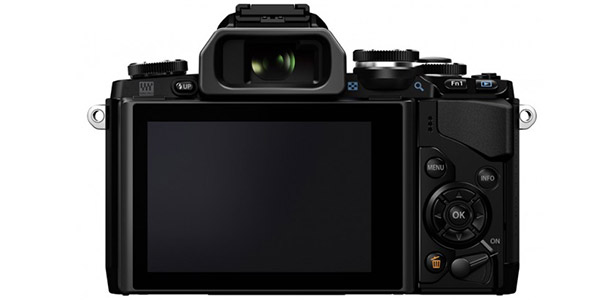
The O-MD E-M10 also has an LCD electronic viewfinder (EVF). It shows the same content as the main screen, though at a slightly higher resolution of 1.4 million pixels, which is enough to verify if your subject is in focus. A sensor enables the viewfinder when you put your eye to it. Some eye sensors are accidentally triggered by fingers or other objects, but we didn’t have any problems with this model. The E-M10 automatically adjusts the brightness of the electronic viewfinder to match the lighting: No more being dazzled by a bright viewfinder when shooting at night.
Controls
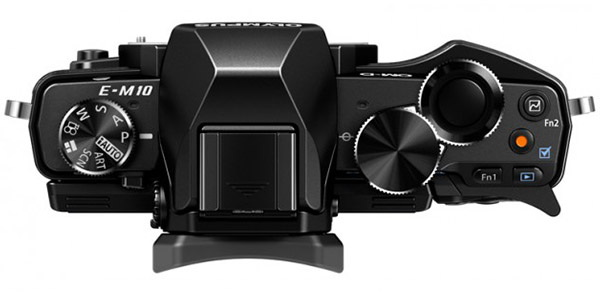
Fifteen buttons and three dials on the M10 camera body put controls at your fingertips. Two dials on the top, in particular, make for a flexible control system. You can simultaneously change things like exposure compensation and aperture while in program mode or both shutter speed and aperture in manual shooting mode. With a little practice, you can use the dials without looking away from the viewfinder while shooting.
The OM-D E-M10 scores respectably in our test of how easy it is to access key settings. However, some commonly used features--such as the drive mode and image resolution--are buried in on-screen menus that require a fair amount of scrolling to reach.
| Setting | Steps/button presses | Function |
| Shutter | 1 | Length of exposure |
| Aperture | 1 | Amount of light let in |
| ISO | 2 | Light sensitivity |
| Focus Mode | 2 | Point or points used for focus |
| Light metering | 1 | Part of image with optimized exposure |
| White balance | 3 | Overall color cast of image |
| Exposure compensation | 1 | Set auto exposure to be darker or lighter |
| Wi-Fi sharing | 1 | Send images to smartphone, activate remote viewfinder |
| Video recording | 1 | Switch from photo to video and back |
| Play | 1 | View images or videos you've shot |
| Delete image | 1 | Self-explanatory |
| Photo capture resolution | 4 | Amount of megapixels |
| Photo capture quality | 3 | Amount of JPEG compression/detail, or RAW |
| Video capture resolution | 3 | Lines of resolution and frame rate |
| Video capture quality | 3 | Amount of compression/detail |
| Drive | 3 | Single photo, burst, timer, etc. |
MORE: DSLRs vs Mirrorless Cameras
Image Quality
The OM-D E-M10 shoots images at a relatively conservative 16.1 megapixels, versus competing models like the Canon T5i (18 MP) or the Nikon D3300 (24 MP). But more megapixels doesn’t automatically mean better photos, and we were generally impressed by the quality of the images that the OM-D E-M10 captured.
We test all cameras with a micro four thirds-size sensor using a prime (non-zooming) lens of about 25mm focal length, which is equivalent to a 50mm lens on a full-frame camera. In this case, we chose the Olympus M-Zukio 25mm f/1.8 MSC lens, priced at about $350. Olympus did not send us the 14-42mm zoom lens that it offers as a kit option. But we did take some shots with a second lens Olympus sent, the 12-50mm, f3.5-6.3 lens (costing $500).
Bright Light Results

Overall, the OM-D E-M10 effectively judged the exposure in bright and average light conditions. We found that its automatic modes did an admirable job balancing aperture, shutter speed and ISO (light-sensitivity) adjustments to get the best results. Shooting in program mode, for example, the OM-D E-M10 accurately judged exposure in a slightly backlit scene of the statue of John Harvard at his namesake university. In it, the face shows excellent detail.

Our examination of the RAW data files from the M10 shows that it can capture rich colors. But these hues looked muted in the JPEG versions of images that the camera produced in its default Normal mode. A shot of a cherry tree, for example, captured the subtleties of the blossoms, but the colors lacked punch. Also, the noise reduction in JPEGs is sometimes rather aggressive, removing not only graininess but also some detail.
You can improve the color quality of JPEGs by selecting the appropriately named Natural Mode art filter setting for the best balance of realism and vibrancy. As with all cameras, you'll get the best color and detail quality if you process the RAW image files yourself in a program such as Photoshop, but not all photographers are that dedicated.

Natural is one of eight Art Filters that the OM-D E-M10 offers. Another, Vivid, lived up to its name, producing almost fluorescent colors.

Olympus also offers 12 of what it calls Art Effects, such as Monochrome, Pop Art, Soft Focus and Grainy Film. The Muted art filter, for example, produces a look reminiscent of color film.
Low Light Results
When the lights go out, a camera needs to boost the ISO setting, making the imaging chip more sensitive to light. This also boosts the noise (graininess) in the image, caused by random electronic fluctuations in the image sensor. The camera's processor can try to remove this noise, but the OM-D E-M10 is a little overaggressive, removing shadow detail in the process.
The OM-D E-M10 did a decent job of keeping the noise at bay, without harming detail, up to ISO 3200, which is good for a camera in this price range. With higher ISO settings, the camera did a decent job of smoothing the noise out, but at the cost of fine detail in the image. You don’t get a lot of say in this process, either; the noise reduction can be set to On, Off or Auto but not to different levels of intensity (unless you process the RAW images by hand). We would recommend keeping the ISO level below 3200.

In a candid shot of a pet taken in a poorly lit room, the M10 bumped the ISO up to 1600, not so high as to harm detail. This required a very slow shutter speed of just 1/13 of a second. This is possible thanks to the camera's in-body image stabilization, which moves the sensor to counteract camera shake. Despite the challenging conditions, the image is very sharp and has a lot of detail, down to the small drops of water on his whiskers.
Video quality
Video feels like something of an afterthought on the OM-D E-M10. While you can start shooting simply by hitting the dedicated Video button, Olympus makes you set the mode dial to Movie to access most of the controls and features, such as the different color modes. The menu setup is also different in movie mode, adding confusion.
Bright light results
The OM-D E-M10 can capture video at a maximum resolution of 1920 by 1080 pixels, with a maximum frame rate of 30 frames per second. It can’t record smoother 60 fps progressive video that some other cameras are capable of (such as the Nikon D3300 and D5300).
Video shot in daylight had realistic color. But even at the maximum quality setting, small details in moving objects were lost in a slight haze, as with the license plates on the vehicles. The sound from the stereo microphone located on the front of the camera body is acceptable, but you are stuck with that. Unlike with several other DSLRs and mirrorless cameras in this price range, the M10 doesn't have an audio input port for connecting a better, external microphone.
Low light results
In low light, the OM-D E-M10 was able to handle multiple light sources well, accurately judging the white balance and not shifting the overall color of the scene out of whack. The camera struggled with focusing, however. At the beginning of our test video, the camera took a couple of seconds to refocus on a distant object.
MORE: Best DSLRs
Autofocus and speed
The OM-D E-M10 has 81 contrast-detection autofocus sensors, like those used in a point-and-shoot camera. It doesn’t have the more advanced phase-detection AF sensors found in DSLRs and many mirrorless cameras, such as Samsung NX30 and NX300, and Olympus's own, more-expensive E-M1.
In daylight and most indoors situations, the E-M10 focuses quickly, and the large number of contrast detection sensors means that it can focus on a subject anywhere in the frame. There are also some nice touches like a face detection focus mode, which allows you to choose which eye to keep the focus on. This feature is useful for portraits, in which you are using a wide aperture (and thus a small depth of field) to blur the background, and need pinpoint focus on the subject.
However, the E-M10 doesn't fare well in low light. When shooting in the late evening or night, we missed shots as the lens buzzed to and fro searching for the right focus point. Often we simply had to switch over to manual focus mode.
The OM-D E-M10 does shoot quickly, though: Olympus claims a maximum shooting speed of 8 frames a second. Shooting with a fast SanDisk HC-1 SDXC memory card, we measured this camera at a speed of 7.8 frames per second, which the camera could maintain for an impressive 23 frames. After that, the buffer memory the camera offers was filled up, and the speed dropped to 1.9 frames per second as the camera had to wait to write the images out to the SD card.
Wireless and GPS
The OM-D E-M10 includes Wi-Fi to connect with smartphone apps. Its support for both 2.4-GHz and 5-GHz networks means faster transfers over the often-crowded airwaves. With the Olympus Image Share app for Android and iOS, you connect the camera and smartphone simply by scanning a QR code displayed on the E-M10's LCD with your smartphone's camera.
From this app, you have complete control of the camera, including settings such as ISO, aperture and shutter speed. You can also select from the camera's built-in art filter effects. The app provides the same image preview you would see on the camera's LCD, and the captured image is then automatically transferred to your phone. All this puts the Image Share app a long way ahead of the competition; it is much more flexible and easy to use than offerings from Sony or Nikon.
Lenses and accessories
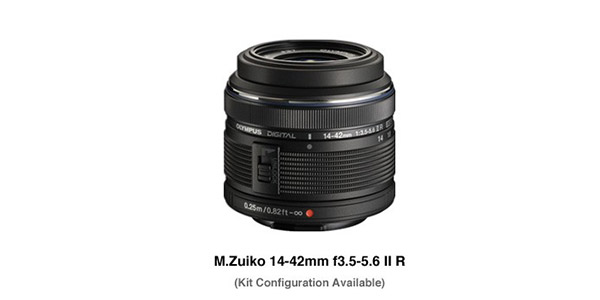
We tested the OM-D M10 with two lenses: a $300 25mm f/1.8 prime lens that meets our standard for testing, as well as a $500 12-50mm, f3.5-6.3 lens that Olympus included with our review unit. Olympus also sells the OM-D E-M10 with a 14-42mm f/3.5-5.6 zoom lens but did not provide one for our review.
The OM-D E-M10 is a Micro Four Thirds camera, which means it can use any lens built for that popular format. This includes lenses from Olympus, Panasonic and other manufacturers, such as Sigma. So there are dozens of lenses available, including ultra-wide lenses, long telephotos and everything in between.
Olympus sells a good selection of accessories for the M10, including three external flash units (priced from $200 to $500). It also sells a $50 carrying case and a $60 screw-on handgrip for better handling (which could come in handy, given the tiny grip the camera comes with).
Bottom Line
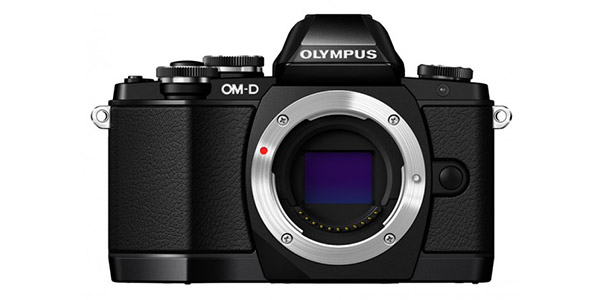
The Olympus OM-D E-M10 offers a lot of compelling features, especially considering the $699 (body only) price. It has a bright and clear tilting touch screen, effective image stabilization, and plenty of shooting modes and controls. What it doesn't have is the more sophisticated features of its more expensive siblings, such as the ability to adjust the level of noise reduction. Nor is it much of a video shooter, though the quality is good enough for casual clips. The OM-D E-M10 hits the fundamentals, however: taking sharp, clean images with accurate color in both good light and low-light conditions.
The focusing system is our main complaint: compared to DSLRs and mirrorless cameras with phase-detection sensors, the E-M10 feels slow and frustrating, which could be a problem for street shooters or others who want to shoot quickly. But for the casual photographer who wants more control than a point-and-shoot offers but not the bulk of a DSLR, the OM-D E-M10 is an attractive, well-priced package.
Specs table
Olympus OM-D E-M10
16 Megapixels
Mirrorless camera
$799 (with 12-50mm lens), $699 (body only)
8 fps burst mode
4/3 Live MOS sensor
12-50mm f/3.5 – 6.3 lens
81 contrast detection points
Shutter speed 1/4000 – 60 sec
ISO 200 – 25,600
Video resolution 1920 by 1080, 1280 by 720, 640 by 480, all at 30fps
Built-in flash
Standard hot shoe
SDXC card slot
HDMI, mini USB ports
802.11a/g/n Wi-Fi
Sensor image stabilization
4.7 by 3.2 by 1.8 inches, 14 ounces
Follow Richard Baguley @rbaguley or on Google+. Follow us @TomsGuide, on Facebook and onGoogle+.
Richard Baguley has been working as a technology writer and journalist since 1993. As well as contributing to Tom's Guide, he writes for Cnet, T3, Wired and many other publications.
